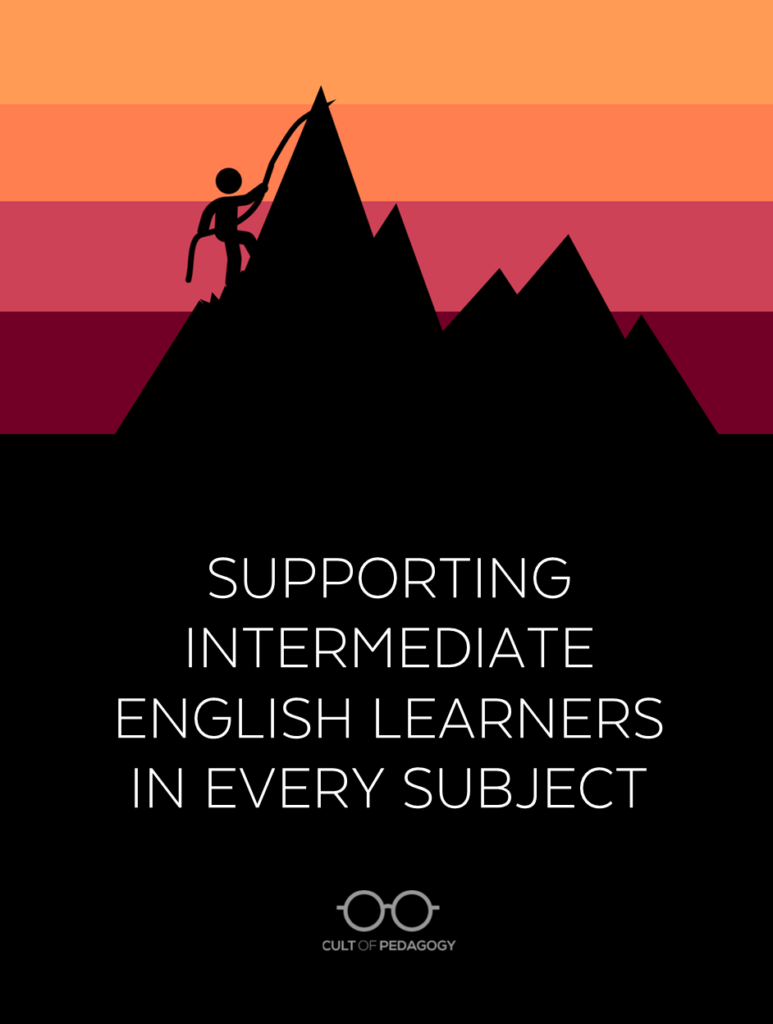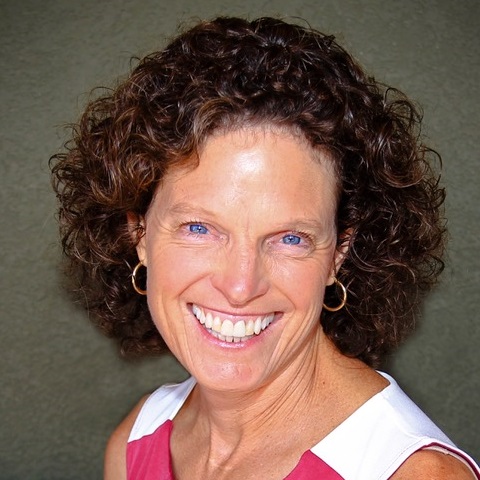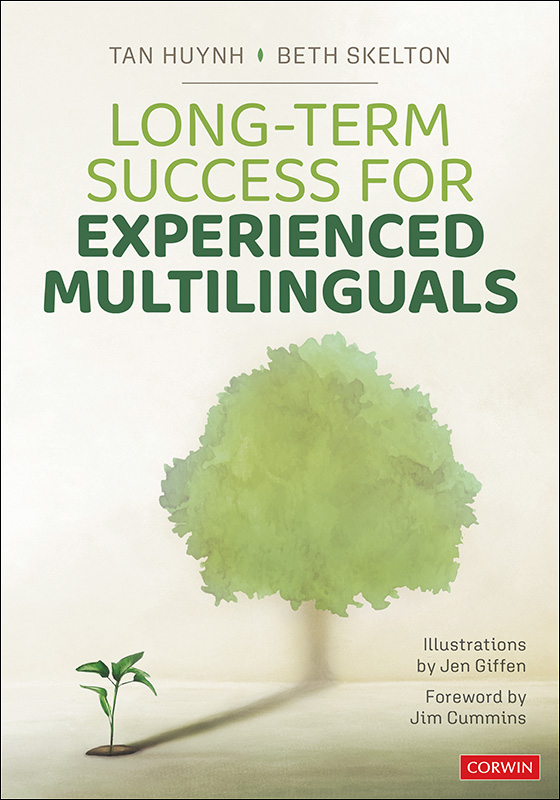
Listen to my interview with Tan Huynh and Beth Skelton (transcript):
Sponsored by Grammar Gap Fillers and Giant Steps
This page contains Amazon Affiliate and Bookshop.org links. When you make a purchase through these links, Cult of Pedagogy gets a small percentage of the sale at no extra cost to you. What’s the difference between Amazon and Bookshop.org?
The population of English learners in our schools continues to grow every year; if you’re a teacher reading this, you have probably taught at least a few students whose first language is not English. In many school systems, students who are newcomers are given lots of support through separate programs or classes with teachers who specialize in building language proficiency, but eventually they move out of these programs and attend regular classes with everyone else. At that point, they are assumed to have enough of a grasp on the English language to perform as well as peers who have spoken English since birth.
But in many cases, that assumption is incorrect. While these students — a group we’re calling experienced multilinguals — are probably quite comfortable and fluent with speaking English socially, they may still be unfamiliar with the academic language used in science, social studies, math, and other content areas. There are specific strategies that can make a huge difference in how well these students perform.
Tan Huynh and Beth Skelton, two educators who have had decades of experience working with English learners, have written a new book called Long-Term Success for Experienced Multilinguals (Amazon | Bookshop.org). The book focuses squarely on this particular population, English learners who are well beyond newcomer status, but who still need some scaffolding to reach their true academic potential. On the podcast, they shared some of the strategies from the book — things you can start to do right away to help these learners thrive. You can listen to our full conversation or read the transcript linked above. Here’s a summary of the strategies they shared.
These kids speak English now, so what’s the problem?
An experienced multilingual student may present a conundrum to their teachers. In many ways, they appear to have developed all the necessary skills, including fluency in English, to do well in school.
“These students have been in this system for at least five years, so they have experience,” Skelton explains. “We don’t have to teach them how to open their locker or how to get to the cafeteria. They have friends. They are in the community. They have experience being a student.”
Despite this ease in navigating school and their social lives, these students can hit a wall when it comes to certain academic tasks.
Huynh has personal experience with this. Having moved to the U.S. as a refugee at the age of 5, his only school experiences were in the U.S. “I went to the ESL program, and I exited in fifth grade,” he says. And that’s when his language support ended. “When you listen to me talk, you’re like, okay, he’s really fluent. We don’t need to help him. And this is what happened all the way through middle school and high school.”
When it came time to take the SAT, he was confident. “I was like, oh, this is going to be fine. My teachers are great. They really took care of me. I’ve had mostly A’s and B’s on most of my exams. I had almost a 4.0 by that time. I had every single award, distinguished, honor, this and that, dean’s list, whatever, I got it. I’m going to be fine. And then I got my score back: 910. I was like, wait, you get a 600 just for putting your name on. How did I get a 910 and I have an almost 4.0 GPA?”
For other multilingual students, things like test scores aren’t quite as surprising, because their school performance isn’t as strong as Huynh’s was. “They often aren’t the award winners and the honor students,” Skelton explains, “and so teachers start to see them as, well, they’ve been in our system since kindergarten or first grade. They’ve been learning English that long, and now you’re in seventh grade, eighth grade, ninth grade, and you’re still classified as an English learner. There must be something wrong with you. They’re still classified as English learners for all kinds of reasons. States require them to have a certain level on an English language proficiency test in order to exit as an English learner. And so when teachers see that, then often that deficit label comes with them.”
With this deficit label, many students are subjected to more and more pull-out coursework to improve their English, which means missing out on electives, extracurriculars, and advanced courses.
“Imagine if a kid comes to school and all they love is just design,” Huynh says. “All they love is just art. They come to school to be in drama. And they say, No no, because of your English scores, you’re out. You’re pulled out.” For a student who may have been born in the U.S. and isn’t even fluent in their heritage language, this can be heartbreaking.
So what is the problem? If extra English classes aren’t helping, what will?
Skelton and Huynh believe the answer lies in academic language. To succeed in all subjects, students need additional scaffolding to understand the unique vocabulary, phrasing, and conventions of those disciplines. When teachers intentionally design instruction and assessments with academic language supports in place, they unlock those worlds for students and give them the tools they need to thrive.


Planning Lessons for Multilingual Learners
If you teach science, math, history, health, technology, even literature — anything other than a class designed to teach a language — your course is built on content-specific standards. You already base your instructional objectives on these standards; Skelton and Huynh recommend adding academic language objectives to those content objectives. This ensures that all students not only get the content, but also the language used to describe and synthesize it.
Here is the process they describe in the book for integrating academic language into what you already teach.
Step 1: Create the Assessment, then Add Scaffolds
Following the backward design approach, start by creating a summative assessment that will measure what students should know and be able to do by the end of a unit. Once the assessment is made, add scaffolding in places where the academic language might prevent students from understanding what’s being asked of them.
Here’s an example: If a test question asks students to hypothesize what would happen if the concentration of oxygen that was consumed inside the glass cylinder increased, they might have a good understanding of the science involved, but some of the terms in the question might throw them off.
“When students encounter a sentence like that,” Huynh says, “it becomes not a science test, it becomes a reading test. If a kid doesn’t understand the word hypothesize, that’s a problem. If they don’t know the word concentration and they Google that, that’s going to be like, oh, focus? What does that mean? And the word consumed and glass cylinder and increase, all these words now add up to a reading test.”
To give students the support they need to do their best on assessments, teachers can “engineer” them by adding these scaffolds:
- synonyms: Near the terms that may be unfamiliar, add synonyms that will help define them. If the teacher has already explicitly taught the term, this may not be necessary. So for the example question, it might look like: “Hypothesize (make an educated guess) what would happen if the concentration (amount) of oxygen that was consumed (used) inside the glass cylinder (container) increased (got higher).”
- sentence starters: Provide students with the academic language needed to construct quality responses in that discipline.
- chunking: Rather than squeeze multiple steps into an essay-type question, break multi-part questions into separate, individual chunks with their own spaces to respond.
- images: Add relevant images to questions to aid comprehension.
- word banks: Provide banks of key vocabulary terms for the unit that students can access when writing responses.
- sequencing: For assessments that require longer responses, provide visual frameworks to show students the sequence in which their response should be written.
While some teachers may feel this is too much hand-holding — for example, they may feel strongly about wanting students to practice reading all parts of a complex question — Huynh and Skelton emphasize that in content-area classes, the focus is on whether students are learning that content; giving multilingual students help with the reading and writing part doesn’t take away from that.
“We haven’t changed the rigor,” Skelton says. “I haven’t changed the expectation. I’ve simply chunked the question. When (teachers) see the difference in response patterns and that kids are able to show more about what they know, most teachers say, You know what? I’m going to do that for everybody. That’s not just for my experienced multilinguals. This is a strategy that’s probably going to be better for everyone in the class.“
Step 2: Write Daily Integrated Objectives
With a good, scaffolded end-of-unit assessment in place, teachers can then work backward to design the lessons that will lead to success at the end. As in any class, this requires daily learning objectives that can be assessed with a simple exit ticket. For multilingual learners, we can add a specific language piece to that objective.
Skelton describes a physics class she observed where students from many language backgrounds were doing a hands-on activity with focal points and convex lenses. At the end of class, the teacher prompted students with this: “Explain what you learned about finding the focal length.”
When one student replied with “It gets bigger when it gets closer,” the teacher was thrilled. He knew what the student meant and felt it adequately showed that he understood.
But when Skelton asked the teacher, “Does that sound like what you would want for a scientific response?” he realized that a real scientist would have used the terms focal point and convex lens. She then had the teacher write out his own response, something that would represent a good response to that question, and this gave him a much better idea of what he was looking for.
The revised prompt, integrating language objectives, looked like this: Explain what you learned about finding the focal length using precise vocabulary from the word bank. By adding this to the objectives, the teacher could then plan instruction that would give students practice in using that language throughout the lesson.
Here are a few more examples:
Before: Compare the social inequality in nineteenth-century France to the reality of the twenty-first century Western society.
After: Compare the social inequality in nineteenth-century France to the reality of the twenty-first century Western society using comparative language (both, just like, another similarity, etc.)
Before: Describe how the graph has been transformed.
After: Describe how the graph has been transformed using precise terms and the phrase by a factor of or by ___ units.
Before: Predict what will happen to the main character in the next chapter.
After: Predict what will happen to the main character in the next chapter using conditional language such as might or could.
Step 3: Teach for Comprehensible Input and Academic Output
When it comes time to teach the lessons themselves, use the daily objective as a guide to ensure that students understand the language that is being used to teach them — in other words, that the input is comprehensible to them — and that the students’ output is framed in the language of the field being taught.
Huynh gives an example from a 9th grade science lesson on solubility. “Imagine a graph, XY graph, and then there’s a line all the way through up. (The teacher) said, ‘Above the line, we call that super saturated. It cannot melt anymore. Below this line, we can keep melting things. We call that unsaturated. That line is saturated. Anything on that line means everything can melt, but it can’t melt anymore.’ So the teacher just drew that, labeled it for kids. She color coded it and made it so comprehensible.”
Next, she posed a few questions to make sure students understood how the graph worked. “She said, ‘Okay. Let’s look at 60 degrees. At what point would we go up, will 60 degrees hit that line of saturation? Let’s look over to the left, oh. It’s 120. That is the solubility.'”
Up to this point, her focus was on comprehensible input, making sure students understood the terms she was using to describe the graph. Next she shifted to the output, giving students practice using the terms themselves. “She said, ‘Now I’m going to give you a question. I’m going to model for you the kind of language I want you to write. Don’t just write the answer. Saturated, unsaturated, that’s not enough. So this is what I want you to do. Always start your sentence with the word at, then give me the amount of grams. So At 110 grams of potassium nitrate… then give me the degrees, at 40 degrees, the solution is… then add is it saturated or unsaturated? And then say, because it is… is it above the line of saturation, below the line of saturation, or on the line of saturation? That’s it.'”
This kind of explicit modeling gives students guided practice in using this unfamiliar language correctly, integrating the content they are learning and the language needed to demonstrate that learning.
No More Doors Closed
By making these small shifts to help students build proficiency in discipline-specific language, we’re helping them reach higher levels of learning. “Instead of lowering the expectations for these students,” Huynh says, “we’re saying, we’re going to keep expectations high, but we’re going to give you different paths to get to that mountaintop.”
And when we do this, we eliminate the need for extra English classes. We put to rest the question of why students who seem to know English perfectly well still struggle in some classes. And we free up space for these students to pursue extracurriculars, electives, advanced coursework, and beyond.
For Huynh, seeing that shift would have personal significance, helping today’s multilingual students reach that mountaintop without the setbacks he had to experience.
“No more doors closed,” he says with resolve. “No more paths blocked.”
Tan Huynh can be found online on his website at tankhuynh.com or on Twitter at @TanKHuynh. Beth Skelton can be found on her website at bethskelton.com or on Twitter at @easkelton.
To purchase Long-Term Success for Experienced Multilinguals directly from Corwin’s website, click here and use the code SAVE20 at checkout for 20 percent off.
Join our mailing list and get weekly tips, tools, and inspiration that will make your teaching more effective and fun. You’ll get access to our members-only library of free downloads, including 20 Ways to Cut Your Grading Time in Half, the e-booklet that has helped thousands of teachers save time on grading. Over 50,000 teachers have already joined—come on in.





